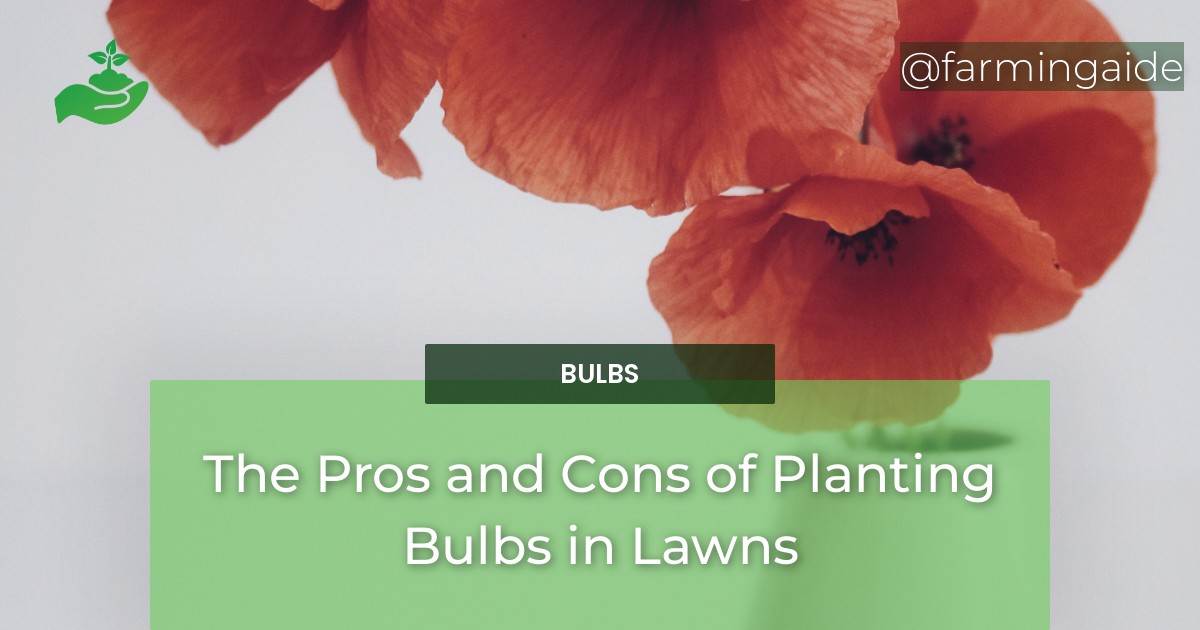Planting bulbs in lawns can add a vibrant touch of color to your garden design, but is it worth it? Before you start digging up your lawn, it’s important to understand the pros and cons of incorporating bulbs into your lawn care routine. In this article, we will discuss the advantages and disadvantages of planting bulbs in your lawn, as well as how it can affect your garden design and lawn care. Whether you’re a seasoned gardener or new to lawn bulbs, this comprehensive guide will help you make an informed decision about whether or not to plant bulbs in your lawn.
The Pros and Cons of Planting Bulbs in Lawns
Advantages of Incorporating Bulbs in Lawns
There are many advantages to planting bulbs in your lawn, including:
1. Adds a Splash of Color
Lawn bulbs can add a pop of color to your garden design. They come in a wide range of colors, from bright and bold to soft and pastel, making them a versatile addition to any lawn. Whether you want to create a cohesive color scheme or add some contrast to your lawn, bulbs can help you achieve your desired aesthetic.
2. Easy to Plant
Planting bulbs in your lawn is a straightforward process that doesn’t require much effort. All you need to do is dig a hole, plant the bulb, and cover it with soil. Unlike other plants that require frequent watering and fertilization, bulbs are low maintenance and can thrive with minimal care.
3. Low Maintenance
Bulbs are a low maintenance plant that requires little attention once they are planted. They don’t need to be watered frequently and can survive periods of drought. Additionally, they don’t require much fertilizer, making them a cost-effective addition to your lawn care routine.
4. Naturalizing Effect
Planting bulbs in your lawn can create a naturalizing effect. This means that over time, the bulbs will spread and create a cohesive look that blends seamlessly with your lawn. Naturalizing bulbs are perfect for creating a wildflower meadow or adding a touch of whimsy to your lawn.
5. Cost Effective
Planting bulbs in your lawn can be a cost-effective way to add some color to your garden design. Unlike other plants that require frequent watering and fertilization, bulbs are a low maintenance plant that can thrive with minimal care.
6. Improves Soil Health
Bulbs are a great way to improve soil health. As they grow, they release nutrients into the soil, which can help other plants in your lawn thrive. Additionally, they can help improve soil structure, making it easier for water to penetrate the soil and reach the roots of other plants in your lawn.
Disadvantages of Incorporating Bulbs in Lawns
While there are many advantages to planting bulbs in your lawn, there are also some disadvantages, including:
1. Risk of Damage
Planting bulbs in your lawn can be risky if you’re not careful. Bulbs can be easily damaged by heavy foot traffic or lawn mowers, which can cause them to stop growing or die altogether. To avoid this, it’s important to plant bulbs in areas of your lawn that don’t get much foot traffic and to mark the areas where they are planted to avoid accidentally mowing over them.
2. Difficulty Mowing
Mowing your lawn can be more difficult with bulbs planted in it. Depending on the type of bulbs you’ve planted, they may need to be cut back at certain times of the year or avoided altogether while mowing. This can make lawn care more time-consuming and complicated.
3. Seasonal Planting
Planting bulbs in your lawn requires seasonal planting. Depending on the type of bulbs you’ve planted, they may need to be planted in the fall or spring, which can limit your planting options and affect your garden design.
4. Limited Plant Variety
Planting bulbs in your lawn can limit your plant variety. While bulbs come in a wide range of colors, they don’t provide the same variety as other plants. This can limit your garden design options and make it difficult to create a truly unique and interesting lawn.
5. Bulbs Attract Pests
Bulbs can attract pests like squirrels, rabbits, and deer, which can damage or eat them. This can be frustrating for gardeners who have put time and effort into planting their bulbs, only to have them destroyed by pests. To avoid this, it’s important to take steps to deter pests, such as using fencing or repellents.
6. Limited Lawn Use
Planting bulbs in your lawn can limit your lawn use. Depending on the type of bulbs you’ve planted, they may need to be left untouched for certain periods of time, which can limit your ability to use your lawn for activities like picnics or sports.
Conclusion
Planting bulbs in your lawn can be a great way to add some color to your garden design and improve soil health. However, it’s important to consider the disadvantages as well, such as the risk of damage and limited plant variety. Ultimately, the decision of whether or not to plant bulbs in your lawn comes down to your personal preferences and gardening goals. By weighing the pros and cons, you can make an informed decision about whether or not to incorporate lawn bulbs into your lawn care routine.


